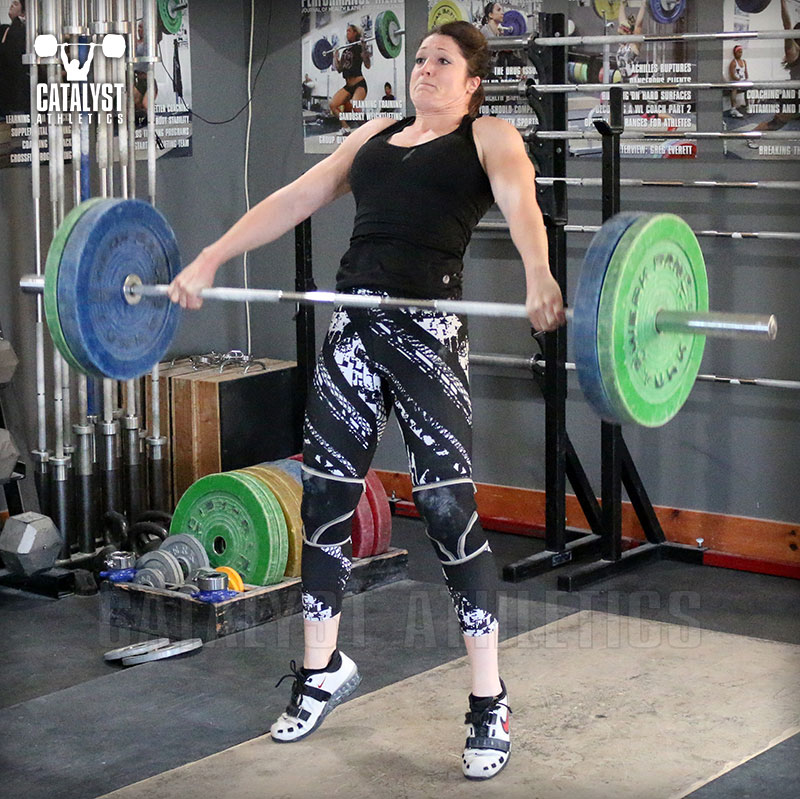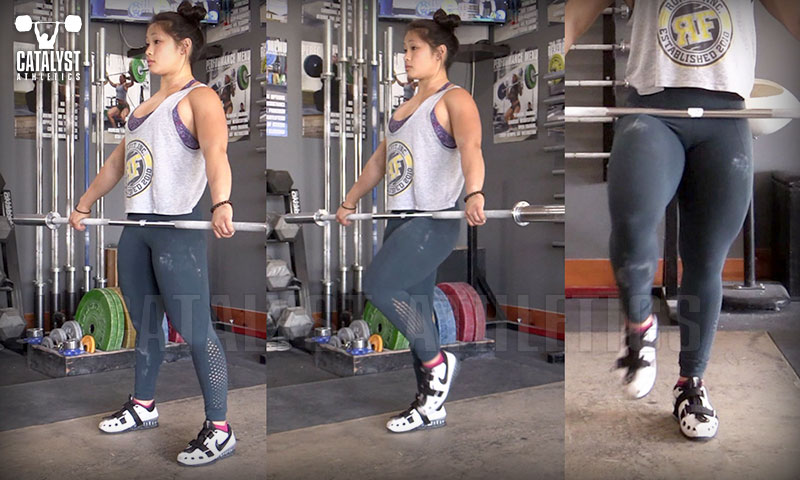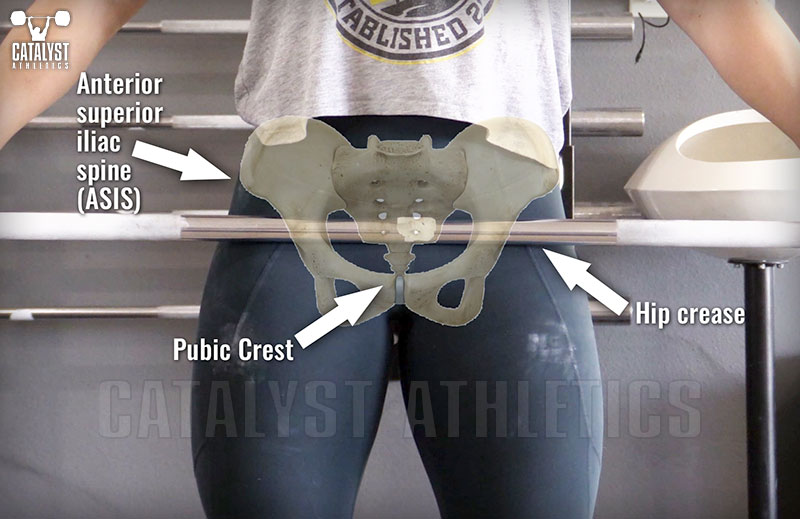Articles
How to Quit Hitting Your Pubic Bone When You Snatch
June 25 2018

June 25 2018

Not many things kill your interest in snatching as quickly as smashing your pubic bone with the bar. That’s why I recommend against it.
I’ve heard a surprising range of advice regarding this problem, and fascinatingly enough, a great deal of it isn’t the only suggestion that makes any sense at all: avoid hitting your pubic bone in the first place.
Being tougher and just dealing with it is a stupid plan. And wearing snatch diapers is even worse. That’s akin to being upset that it hurts every time you hit yourself in the head with a hammer and deciding the best solution is to wear a helmet. More importantly… you’re literally wearing padded shorts. I shouldn’t have to say any more on that.
But I have such explosive hips! I’m too powerful to not hit it hard and make it hurt! Absolutely missing the point. There is NO reason you can’t be the most powerful, violent, hip-dominant lifter in the world and STILL not smash your pubic bone with the bar. What I tell you below will have nothing to do with being less aggressive or using less hip extension.
So let’s get this straight: The only sensible solution to avoiding the pain of hitting your pubic bone when you snatch is to stop hitting your pubic bone when you snatch.
The great thing is that there are really only two things you need to do to make this happen, one of which is the simplest thing in the world, and the other of which may take you some practice and training.
Grip Width
If your grip on the bar has the bar touching your pubic bone when holding the bar at arms’ length in a standing position, try to take a guess at what’s going to happen when you snatch. This is not the correct bar position and grip width. Can’t get any simpler than that.
To get the proper grip, stand with the bar at arms’ length and adjust your hands until the bar is in the crease of your hips. Now, I’ve noticed more and more recently that people don’t understand what this means, so I’m going to make it impossible to misunderstand.
Lift one knee in this position. Where your body hinges is the crease of the hip. Don’t lift the knee all the way up, just enough to create that clear point on your body. Adjust your grip until the bar hits right in that crease.

Lift a knee to find the hip crease and adjust your grip width until the bar hits that point.
To make absolutely sure you’re in the right place, a quick anatomy lesson: We’re trying to get the bar to contact in the soft tissue between the pubic crest (bottom) and anterior superior iliac crests (top). Not only is this where the bar should be hitting because it’s best for the mechanics of the lift, but it’s also a safe spot between bony borders—you can slam the bar into that area as hard as you want without any real pain or problems.

The bar should contact the body in the soft tissue between the pubic bone and the anterior superior iliac spines.
Timing
Even if you’ve established the proper grip width in the standing position, it’s still possible to snag your pubic bone during a lift if you’re not executing the motion correctly. Initiating the second pull—starting to open the hips—too early is almost always the cause of hitting the pubic bone when your grip is correct. It will simply cause the bar to contact sooner and lower.
Make staying over the bar longer and waiting to initiate the final upward explosion a focus in your snatches, and reinforce the position and strengthen your ability to maintain it with halting snatch deadlifts, snatch segment pulls with pauses at mid-thigh, and slow-pull snatches.
Adjusting for Unusual Proportions
Finding the correct grip width for the snatch is as simple as it gets… unless you have non-standard issue proportions. With a short trunk and long arms, the standard for grip width I described above may be impossible for you to achieve because you actually can’t get your hands that far out on the bar (if you’re really tall) or the angles are so extreme that your overhead position is painful and/or unstable. You’re going to simply have to get your grip as close to “ideal” as possible.
The bad news is that you are not built for this sport, but I don’t think that’s news to you. The good news is that we can manipulate the bar contact point a bit without rowing the bar up with the arms like a goofball.
First, you’re going to have to be even more diligent about staying over the bar long enough. Second, you can shrug up and back a bit as you enter the second pull—this is a strong motion/position that you’ll be able to maintain in the extension, and you can get a surprising amount of bar movement out of it. All you should need is an inch or two.
See all this in quick video form:
I’ve heard a surprising range of advice regarding this problem, and fascinatingly enough, a great deal of it isn’t the only suggestion that makes any sense at all: avoid hitting your pubic bone in the first place.
Being tougher and just dealing with it is a stupid plan. And wearing snatch diapers is even worse. That’s akin to being upset that it hurts every time you hit yourself in the head with a hammer and deciding the best solution is to wear a helmet. More importantly… you’re literally wearing padded shorts. I shouldn’t have to say any more on that.
But I have such explosive hips! I’m too powerful to not hit it hard and make it hurt! Absolutely missing the point. There is NO reason you can’t be the most powerful, violent, hip-dominant lifter in the world and STILL not smash your pubic bone with the bar. What I tell you below will have nothing to do with being less aggressive or using less hip extension.
So let’s get this straight: The only sensible solution to avoiding the pain of hitting your pubic bone when you snatch is to stop hitting your pubic bone when you snatch.
The great thing is that there are really only two things you need to do to make this happen, one of which is the simplest thing in the world, and the other of which may take you some practice and training.
Grip Width
If your grip on the bar has the bar touching your pubic bone when holding the bar at arms’ length in a standing position, try to take a guess at what’s going to happen when you snatch. This is not the correct bar position and grip width. Can’t get any simpler than that.
To get the proper grip, stand with the bar at arms’ length and adjust your hands until the bar is in the crease of your hips. Now, I’ve noticed more and more recently that people don’t understand what this means, so I’m going to make it impossible to misunderstand.
Lift one knee in this position. Where your body hinges is the crease of the hip. Don’t lift the knee all the way up, just enough to create that clear point on your body. Adjust your grip until the bar hits right in that crease.

Lift a knee to find the hip crease and adjust your grip width until the bar hits that point.
To make absolutely sure you’re in the right place, a quick anatomy lesson: We’re trying to get the bar to contact in the soft tissue between the pubic crest (bottom) and anterior superior iliac crests (top). Not only is this where the bar should be hitting because it’s best for the mechanics of the lift, but it’s also a safe spot between bony borders—you can slam the bar into that area as hard as you want without any real pain or problems.

The bar should contact the body in the soft tissue between the pubic bone and the anterior superior iliac spines.
Timing
Even if you’ve established the proper grip width in the standing position, it’s still possible to snag your pubic bone during a lift if you’re not executing the motion correctly. Initiating the second pull—starting to open the hips—too early is almost always the cause of hitting the pubic bone when your grip is correct. It will simply cause the bar to contact sooner and lower.
Make staying over the bar longer and waiting to initiate the final upward explosion a focus in your snatches, and reinforce the position and strengthen your ability to maintain it with halting snatch deadlifts, snatch segment pulls with pauses at mid-thigh, and slow-pull snatches.
Adjusting for Unusual Proportions
Finding the correct grip width for the snatch is as simple as it gets… unless you have non-standard issue proportions. With a short trunk and long arms, the standard for grip width I described above may be impossible for you to achieve because you actually can’t get your hands that far out on the bar (if you’re really tall) or the angles are so extreme that your overhead position is painful and/or unstable. You’re going to simply have to get your grip as close to “ideal” as possible.
The bad news is that you are not built for this sport, but I don’t think that’s news to you. The good news is that we can manipulate the bar contact point a bit without rowing the bar up with the arms like a goofball.
First, you’re going to have to be even more diligent about staying over the bar long enough. Second, you can shrug up and back a bit as you enter the second pull—this is a strong motion/position that you’ll be able to maintain in the extension, and you can get a surprising amount of bar movement out of it. All you should need is an inch or two.
See all this in quick video form:

Greg Everett
Alyssa Sulay